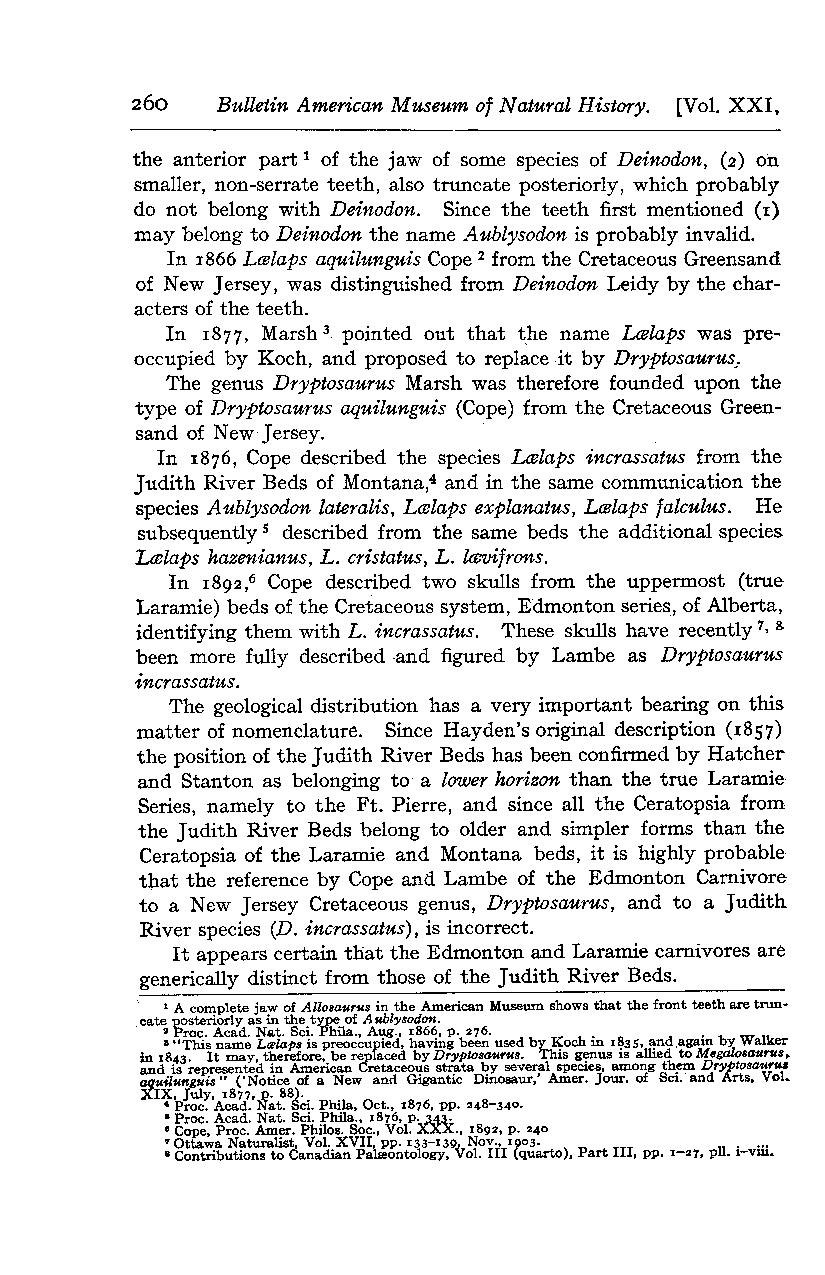the anterior part[1] of the jaw of some species of Deinodon, (2) on smaller, non-serrate teeth, also truncate posteriorly, which probably do not belong with Deinodon. Since the teeth first mentioned (1) may belong to Deinodon the name Aublysodon is probably invalid.
In 1866 Lælaps aquilunguis Cope[2] from the Cretaceous Greensand of New Jersey, was distinguished from Deinodon Leidy by the characters of the teeth.
In 1877, Marsh[3] pointed out that the name Lælaps was preoccupied by Koch, and proposed to replace it by Dryptosaurus.
The genus Dryptosaurus Marsh was therefore founded upon the type of Dryptosaurus aquilunguis (Cope) from the Cretaceous Greensand of New Jersey.
In 1876, Cope described the species Lælaps incrassatus from the Judith River Beds of Montana,[4] and in the same communication the species Aublysodon lateralis, Lælaps explanatus, Lælaps falculus. He subsequently[5] described from the same beds the additional species Lælaps hazenianus, L. cristatus, L. lævifrons.
In 1892,[6] Cope described two skulls from the uppermost (true Laramie) beds of the Cretaceous system, Edmonton series, of Alberta, identifying them with L. incrassatus. These skulls have recently[7], [8] been more fully described and figured by Lambe as Dryptosaurus incrassatus.
The geological distribution has a very important bearing on this matter of nomenclature. Since Hayden's original description (1857) the position of the Judith River Beds has been confirmed by Hatcher and Stanton as belonging to a lower horizon than the true Laramie Series, namely to the Ft. Pierre, and since all the Ceratopsia from the Judith River Beds belong to older and simpler forms than the Ceratopsia of the Laramie and Montana beds, it is highly probable that the reference by Cope and Lambe of the Edmonton Carnivore to a New Jersey Cretaceous genus, Dryptosaurus, and to a Judith River species (D. incrassatus), is incorrect.
It appears certain that the Edmonton and Laramie carnivores are generically distinct from those of the Judith River Beds.
- ↑ A complete jaw of Allosaurus in the American Museum shows that the front teeth are truncate posteriorly as in the type of Aublysodon.
- ↑ Proc. Acad. Nat. Sci. Phila., Aug., 1866, p. 276.
- ↑ "This name Lælaps is preoccupied, having been used by Koch in 1835, and again by Walker in 1843. It may, therefore, be replaced by Dryptosaurus. This genus is allied to Megalosaurus, and is represented in American Cretaceous strata by several species, among them Dryptosaurus aquilunguis" ('Notice of a New and Gigantic Dinosaur,' Amer. Jour. of Sci. and Arts, Vol. XIX, July, 1877, p. 88).
- ↑ Proc. Acad. Nat. Sci. Phila, Oct., 1876, pp. 248–340.
- ↑ Proc. Acad. Nat. Sci. Phila., 1876, p. 343.
- ↑ Cope, Proc. Amer. Philos. Soc., vol. XXX., 1892, p. 240
- ↑ Ottawa Naturalist, Vol. XVII, pp. 133–139, Nov., 1903.
- ↑ Contributions to Canadian Palæontology, Vol. III (quarto), Part III, pp. 1–27, pll. i–viii.

